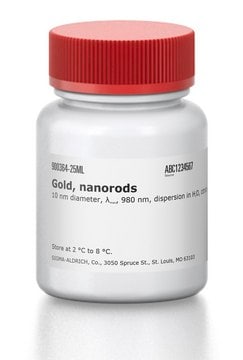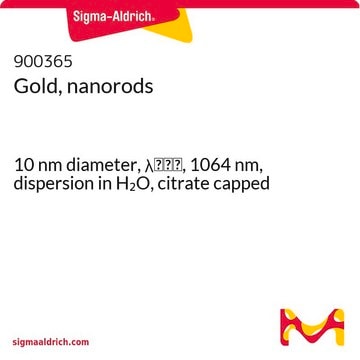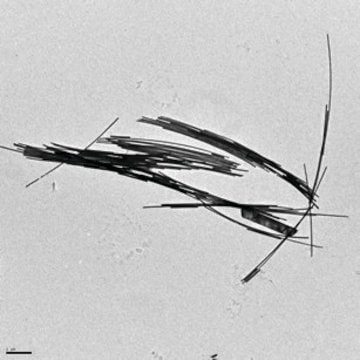771686
Gold nanorods
25 nm diameter, λmax, 650 nm, dispersion in H2O
Sinonimo/i:
Au nanorods, Gold nanorod
About This Item
Prodotti consigliati
Forma fisica
colloidal suspension
dispersion in H2O
nanorod
contiene
CTAB as stabilizer
Concentrazione
>45 μg/mL in H2O
diam. × lung.
25 nm × 60 nm (±10%)
Diametro
25 nm
λmax
650 nm
Mw/Mn
>95 (rods)
Temperatura di conservazione
2-8°C
InChI
1S/Au
PCHJSUWPFVWCPO-UHFFFAOYSA-N
Cerchi prodotti simili? Visita Guida al confronto tra prodotti
Categorie correlate
Descrizione generale
Applicazioni
Caratteristiche e vantaggi
Note legali
Codice della classe di stoccaggio
10 - Combustible liquids
Classe di pericolosità dell'acqua (WGK)
WGK 2
Punto d’infiammabilità (°F)
Not applicable
Punto d’infiammabilità (°C)
Not applicable
Certificati d'analisi (COA)
Cerca il Certificati d'analisi (COA) digitando il numero di lotto/batch corrispondente. I numeri di lotto o di batch sono stampati sull'etichetta dei prodotti dopo la parola ‘Lotto’ o ‘Batch’.
Possiedi già questo prodotto?
I documenti relativi ai prodotti acquistati recentemente sono disponibili nell’Archivio dei documenti.
I clienti hanno visto anche
Articoli
Gold nanostructures such as nanorods, nanowires and microgold have found applications in exciting fields such as biomedical engineering, catalysis and diagnostics.
Silver nanomaterials have unique physical, chemical, and optical properties that are currently being leveraged for a wide variety of biological applications.
Among various ceramics, one-dimensional (1-D) piezoelectric ceramics have attracted significant scientific attention for use in energy harvesting.
Recent research highlights tunable properties of inorganic nanoparticles, driving interest in optoelectronics.
Il team dei nostri ricercatori vanta grande esperienza in tutte le aree della ricerca quali Life Science, scienza dei materiali, sintesi chimica, cromatografia, discipline analitiche, ecc..
Contatta l'Assistenza Tecnica.![Dichlorodi-μ-chlorobis[(1,2,3,6,7,8-η-2,7-dimethyl-2,6-octadiene-1,8-diyl]diruthenium(IV) 97%](/deepweb/assets/sigmaaldrich/product/structures/183/511/879fb3f2-220a-45c9-bb2b-3799730a6693/640/879fb3f2-220a-45c9-bb2b-3799730a6693.png)



![RuCl(p-cymene)[(S,S)-Ts-DPEN]](/deepweb/assets/sigmaaldrich/product/structures/596/849/f8e3d2d8-a02e-430e-b0ed-c208cea3a6fb/640/f8e3d2d8-a02e-430e-b0ed-c208cea3a6fb.png)


